As heated rallies continue in the US, David G. Bromley looks at the nation’s history to bring some perspective to its current conflicts.

Among the most critical questions currently confronting America is who we are and where we are. Sometimes it is more pointed: Is there a “we” at all; are we or can we ever achieve a nation undivided, a “more perfect union?” At this moment in our history, that is a fair question. There is no denying that America is deeply divided and that relations often are tribal and decidedly uncivil. Indeed, one of the interpretive concepts that is frequently invoked now in discussions of current polarisation is civil war. This approach is attractive as we currently witness widespread circulation of conspiracy theories, ongoing acts of violence, and attempted insurrection. These could be a forerunner to the larger-scale, organised, sustained violent struggle for political dominance within a nation that defines civil war.
An alternative path to gaining perspective on the current moment is to compare our position now with our situation at an earlier point in American history, when there actually was a civil war. There is some risk, of course, in comparing a moment in which an event actually occurred with one in which an apparently similar event might occur. That said, the value in this comparative perspective is that both moments of conflict occurred in different eras in the same society, culture, and polity over many of the same issues. For example, race was the core issue in the first national crisis and it remains a defining issue in the second. The other important insight is that both crisis periods involved seismic upheavals in American society. The first began around mid-nineteenth century and the other in the latter twentieth century. In the first crisis, the Industrial Revolution involved a massive population shift to industrial centres, primarily in the North, with the result that the U.S. population became half urban in 1920. Urban-rural conflict intensified as the political and economic power of urban centres rapidly expanded. In the current crisis, a new internationally based technology and information economy, which is still unfolding, is rapidly creating a “global village” that reorders power and privilege once again. Understanding the current moment therefore begins with recognising that current conflicts have deep roots in American history that have remained unresolved and that are simply manifesting at a different point in our historical evolution.
In the earlier struggle the division was between an emerging urban-industrial order in the North and a rural-agrarian order in the South. In the North, the core issue was culturally and legally embedded slavery, ownership of humans as property by other humans. That could not serve as a blueprint for an industrial economy. It would impact the functioning of every other institution, it would undermine the basic role of a constitutional republic (citizen), and it would delegitimate the moral underpinning of a nation presenting itself as in pursuit of a “more perfect union.” For the South, a caste-like racial hierarchy was built into every aspect of life, and the economic engine of southern economies, the plantation system, could not be sustained absent a coercively organised labour force. Southern states drew a line in the sand, insisting that states’ rights were enshrined in the constitution and slavery was not explicitly prohibited. With the outbreak of the Civil War, President Abraham Lincoln concluded that consensual resolution of North-South divisions was unattainable; the Emancipation Proclamation was issued in 1863, which initially was enforced only in those areas under federal control. With the cessation of military activity, the 13th Amendment ending slavery was passed in 1865.
The end of military engagement did not eliminate North-South divisions, however. Following a decade long Reconstruction Period (1865-1877), the former states of the Confederacy replaced slavery with Jim Crow laws (segregation of all public facilities), increased voting restrictions (strict registration processes, poll taxes, literacy tests), white control of state governments, and extra-legal violence (lynching). At the national level, the former Confederate states constituted a formidable minority power base. The Supreme Court’s 1896 legitimation of “separate but equal” in Plessy v Ferguson legitimated racial separation at the highest judicial level. In addition, a loosely organised Lost Cause movement emerged that sacralised southern culture through memorial monuments, cemeteries, museums, educational curricula, holidays, and battle re-enactments. The South may have been subjugated militarily, but the Lost Cause narrative asserted that the South had won a moral victory that demonstrated the superiority of its culture and way of life. Many elements of that remarkably successful southern heritage building, racial suppression system and Lost Cause narrative remained in place until the 1960s. The overturning of Plessy in Brown v Board of Education in 1954 was followed by passage of the Civil Rights Act and Voting Rights Act in 1964 and 1965. The process that gathered momentum after 2010 with movements, such as Black Lives Matter, and legal prosecutions of extra-legal police violence and mass shootings.
A century and a half later America finds itself in the midst of another major social and cultural transformation, which social scientists refer to as the process of “globalisation.” There is broad agreement that around the last decade of the 2000s the pace and impact of this process accelerated dramatically. Important elements of what is now often called the “global village” include, for example, more rapid social change that favours flexibility and adaptability over tradition and stability; national independence and control giving way to international networks and mutual interdependence; religious, ethnic and racial diversity that undermines historic dominance by established groups and populations; permeable boundaries that encourage the free flow of populations, ideas, technology, and commerce and that resets competitive advantage; expanded individual choice in matters of lifestyle and personal identity that replaces traditional gender and relationship categories. Conflict has intensified as the divide between two alternative ways of living widens. Many of the most intense contemporary social flashpoints are revealing as they track back to this fault-line.
The epicentre of resistance incorporates both former Confederate states and other places in which there is a concentration of the white, Christian, nationalist population. Put most simply this population seeks to fuse and privilege American, white, and Christian, male as constituting authentic America.
It is therefore unsurprising that the form that contemporary resistance takes mirrors the earlier conflict. Strident forms of Christianity have emerged in conservative Bible churches and megachurches that sacralise white nationalist and conspiracy themes. Confederate flags are prominent at protest events. There have been calls for stronger assertion of state rights and even national “divorce” (secession bills in state legislatures, a movement to mandate an Article Five convention to rewrite the U.S. Constitution). Concerted efforts continue to restrict voter eligibility and participation in ways that are reminiscent of the Jim Crow era. Death threats and real violence are directed at individuals and groups that are perceived as dangerous (African Americans, immigrants, LGBT populations, abortion rights groups). There have even been organised insurrection attempts.
In this moment it is imperative to recognise that the current situation the nation faces is the product of our collective history and not solely of seditious insurrectionists, as one side would have it, or the depraved “deep state,” as the other side would have it. The problems that we face have proved intractable through much of our history. Indeed, when future historians update American history, the periods around 1860 and 2020 will both be recorded as pivotal historical moments. This means that the current moment, fraught though it is, offers an opportunity to decide once again who we want to be as a nation. We can reaffirm the progress that has been made toward realising our ultimate values and core identity while also recognising that the journey ahead will test our commitment. At the end of the day, summoning what Lincoln called our “better angels” is the only viable path to a “more perfect union”.





